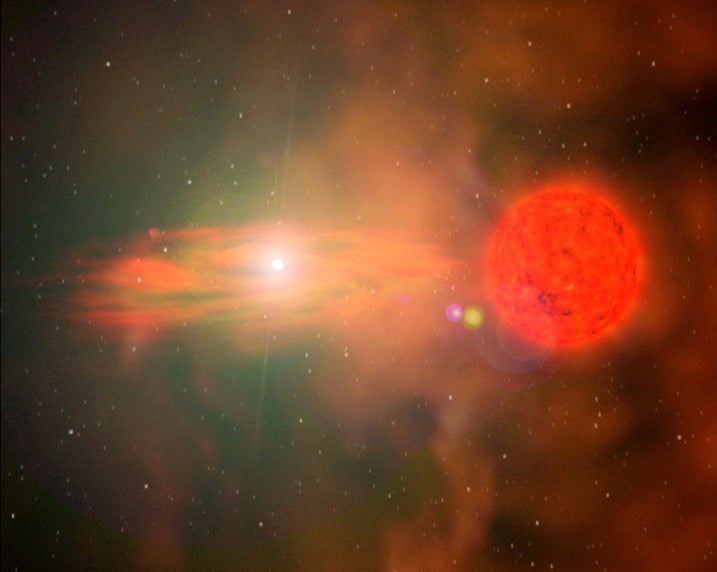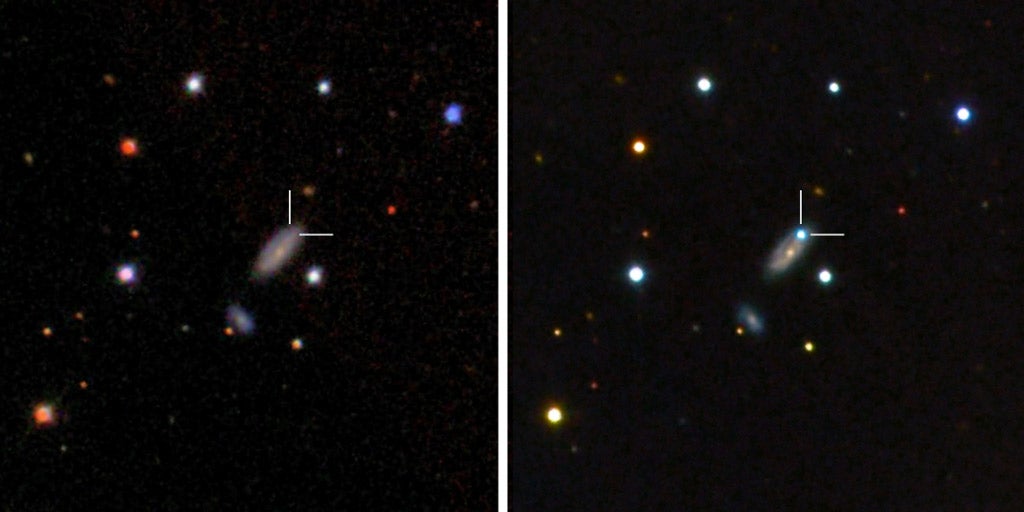The astronomers conclude that there are multiple ways to make a type Ia supernova — a finding that could have implications for understanding the differences seen in these “standard candles” that were used to reveal the presence of dark energy.
Supernova PTF 11kx was discovered by the Palomar Transient Factory (PTF) in a galaxy 600 million light-years away — relatively nearby in astronomical terms, but like all type Ia supernovae, much too far away to make out the details of the stars before they exploded. However, the astronomers could discern that the supernova was surrounded by shells of gas, some of it containing hydrogen that had likely been cast off in previous nova eruptions, decades before the supernova occurred. These are much more frequent weak explosions that do not destroy the star. While similar shells of material had been seen before in a handful of type Ia supernovae, their origin was debated, and they had never before been firmly linked to novae. Some doubted that the material was even near to the supernova at all.
PTF 11kx was different. The surrounding gas was moving too slowly to be from the supernova, but too fast to be a typical stellar wind. Lars Bildsten, director of UCSB’s Kavli Institute for Theoretical Physics, hypothesized that it was material shot out from a previous nova eruption, which had been slowed as it collided with the wind from the red giant star. Calculations from UCSB graduate student Kevin Moore showed this hypothesis to be plausible, and would lead to gas moving at speeds seen in the observations. Adding credence to the theory was the fact that the material moved at two different speeds — faster-moving material interior to slower-moving material — exactly as expected. The farthest-out material had been slowing for decades, while the interior material had less time to slow.
But if this was the case, the very fast-moving supernova ejecta should have eventually collided with the nova material. About two months after the explosion, this is exactly what happened. New observations showed that the supernova ejecta was smashing into the interior shell of material. It was impossible to doubt that this gas was near the supernova.
“This was the most exciting supernova I’ve ever studied,” said Dilday. “For several months, almost every new observation showed something we’d never seen before.”
Could novae explain all supernovae? The PTF team previously showed that SN 2011fe, the closest type Ia supernova in 25 years, could not be a nova of the type suspected in PTF 11kx. And any red giant in the binary system is expected to survive the explosion of the white dwarf. A recent study found no such survivor in a nearby supernova remnant and concluded that it must have been caused by the merger of two white dwarf stars. Finally, other studies showed that some supernovae are so bright that they almost certainly result from the merger of two white dwarf stars.
Predicting the exact number of supernovae that may arise from novae is difficult because the study’s authors think they got lucky and saw the nova at just the right angle so that they could infer its presence. But novae look very different from different directions, so if they had seen the explosion from a different perspective, they might have missed it. Still, they estimate that novae give rise to more than one-tenth of a percent of all type Ia supernovae, but less than 20 percent.
Andy Howell, second author on the study, said: “It is a total surprise to find that thermonuclear supernovae, which all seem so similar, come from different kinds of stars. It is like discovering that some humans evolved from ape-like ancestors, and others came from giraffes. How could they look so similar if they had such different origins?” Howell is the leader of the supernova group at LCOGT, and is an adjunct faculty member in physics at UCSB.
Recently, some studies have found that type Ia supernovae are not perfect standard candles — their brightness depends on the type of galaxy in which they were discovered. The reason is a mystery, but the finding that some type Ia supernovae come from different progenitors would seem to suggest that the supernova’s ultimate brightness may be affected by whether or not it comes from a nova or a white dwarf merger.
“We don’t think this calls the presence of dark energy into question,” said Dilday, “but it does show that if we want to make progress understanding it, we need to understand supernovae better.”











